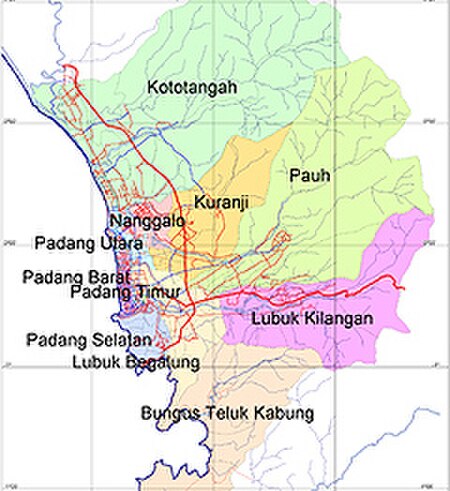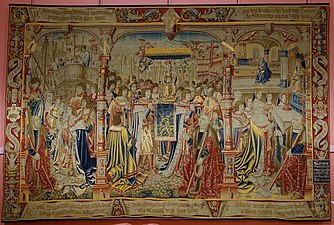Kaiserliche Reichspost
|
Read other articles:

Men in BlackLogo del filmTitolo originaleMen in Black Paese di produzioneStati Uniti d'America Anno1997 Durata98 min Rapporto1,85:1 Genereazione, commedia, fantascienza, avventura RegiaBarry Sonnenfeld SoggettoLowell Cunningham (fumetto) SceneggiaturaEd Solomon ProduttoreWalter F. Parkes, Laurie MacDonald Produttore esecutivoSteven Spielberg Casa di produzioneColumbia Pictures, Amblin Entertainment, Parker/MacDonald Productions Distribuzione in italianoColumbia TriStar Films Italia F…

This article has multiple issues. Please help improve it or discuss these issues on the talk page. (Learn how and when to remove these template messages) This article may require copy editing for grammar, style, cohesion, tone, or spelling. You can assist by editing it. (June 2023) (Learn how and when to remove this message) This article needs additional citations for verification. Please help improve this article by adding citations to reliable sources. Unsourced material may be challenged and …

2016年美國總統選舉 ← 2012 2016年11月8日 2020 → 538個選舉人團席位獲勝需270票民意調查投票率55.7%[1][2] ▲ 0.8 % 获提名人 唐納·川普 希拉莉·克林頓 政党 共和黨 民主党 家鄉州 紐約州 紐約州 竞选搭档 迈克·彭斯 蒂姆·凱恩 选举人票 304[3][4][註 1] 227[5] 胜出州/省 30 + 緬-2 20 + DC 民選得票 62,984,828[6] 65,853,514[6] 得…

莎拉·阿什頓-西里洛2023年8月,阿什頓-西里洛穿著軍服出生 (1977-07-09) 1977年7月9日(46歲) 美國佛羅里達州国籍 美國别名莎拉·阿什頓(Sarah Ashton)莎拉·西里洛(Sarah Cirillo)金髮女郎(Blonde)职业記者、活動家、政治活動家和候選人、軍醫活跃时期2020年—雇主內華達州共和黨候選人(2020年)《Political.tips》(2020年—)《LGBTQ國度》(2022年3月—2022年10月)烏克蘭媒體�…

Éphémérides Chronologie du Québec 1829 1830 1831 1832 1833 1834 1835Décennies au Québec :1800 1810 1820 1830 1840 1850 1860 Chronologie dans le monde 1829 1830 1831 1832 1833 1834 1835Décennies :1800 1810 1820 1830 1840 1850 1860Siècles :XVIIe XVIIIe XIXe XXe XXIeMillénaires :-Ier Ier IIe IIIe Chronologies géographiques Afrique Afrique du Sud, Algérie, Angola, Bénin, Botswana, Burkina Faso, Bu…

A Tale of Legendary LibidoPoster teatrikalSutradaraShin Han-solProduserLee Seo-yeolKim Sang-ilDitulis olehShin Han-solPemeranBong Tae-gyuKim Shin-ahOh Dal-suPenata musikKim Tae-seongSinematograferLee Hyung-deokPenyuntingMoon In-daePerusahaanproduksiPrime EntertainmentDistributorShowboxTanggal rilis 30 April 2008 (2008-04-30) Durasi120 menitNegaraKorea SelatanBahasaKoreaPendapatankotorUS$1,7 juta[1] A Tale of Legendary Libido (Hangul: 가루지기; RR: Gar…

The Claas Cougar is a self-propelled mower produced by the German agricultural machinery manufacturer Claas. The mower, which is named after the cougar, a large American cat, was first presented in 2003.[1] Due to its maximum cutting width of 14 metres (46 ft) it is classified as the largest self-propelled mower in the world.[citation needed] A Claas Cougar 1400 at Wisconsin International Raceway in 2008 Dimensions and technology The base model Cougar 1400 is available in di…

This article relies largely or entirely on a single source. Relevant discussion may be found on the talk page. Please help improve this article by introducing citations to additional sources.Find sources: List of educational institutions in Thalassery – news · newspapers · books · scholar · JSTOR (February 2021) This is a list of educational institutions in Thalassery, a city on the Malabar Coast of Kerala, India. Schools MMHSS(MUBARAK) SAIDARPALLY Basel …

Nazi Holocaust perpetrator (1891–1948) Otto RaschRasch's mugshot after his indictment for the Nuremberg Military Tribunal (July 1947)Born7 December 1891Friedrichsruh, German EmpireDied1 November 1948(1948-11-01) (aged 56)Wehrstedt, Lower Saxony, Allied-occupied GermanyKnown forBabi Yar massacreCriminal statusDeceasedMotiveNazismCriminal chargeCrimes against humanityWar crimesMembership in a criminal organizationTrialEinsatzgruppen trialDetailsVictims80,000+Span of crimes1939–1…

Set algebra redirects here. For the basic properties and laws of sets, see Algebra of sets. Algebraic concept in measure theory, also referred to as an algebra of sets In mathematics, a field of sets is a mathematical structure consisting of a pair ( X , F ) {\displaystyle (X,{\mathcal {F}})} consisting of a set X {\displaystyle X} and a family F {\displaystyle {\mathcal {F}}} of subsets of X {\displaystyle X} called an algebra over X {\displaystyle X} that contains the empty set as an element, …

Empasan jenis plunging Gelombang pecah besar Gelombang pecah atau empasan dalam dinamika fluida adalah gelombang yang amplitudonya mencapai level kritis sehingga terjadi beberapa proses tertentu yang mengakibatkan sebagian energi gelombang berubah menjadi energi kinetik turbulen.[1][2] Pada kondisi ini, model fisik sederhana yang mendeskripsikan dinamika gelombang seringkali menjadi tidak valid, terutama pada model yang mengasumsikan kondisi gelombang linear. Bentuk gelombang pec…

Early Buddhist monastic schools This article needs additional citations for verification. Please help improve this article by adding citations to reliable sources. Unsourced material may be challenged and removed.Find sources: Early Buddhist schools – news · newspapers · books · scholar · JSTOR (April 2009) (Learn how and when to remove this message) Map of the major geographical centers of major Buddhist schools in South Asia, at around the time of Xuanz…

Questa voce o sezione sull'argomento Competizioni calcistiche non è ancora formattata secondo gli standard. Commento: Si invita a seguire il modello di voce Contribuisci a migliorarla secondo le convenzioni di Wikipedia. Segui i suggerimenti del progetto di riferimento. Prva liga SR Jugoslavije 1998-1999 Competizione Prva liga SR Jugoslavije Sport Calcio Edizione 7ª Organizzatore FSJ Date dal 7 agosto 1998al 20 marzo 1999 Luogo Jugoslavia Partecipanti 18 Risultati Vincitore …

Internet country code top-level domain for Saint Pierre and MiquelonThis article is about the top level domain. For the file extension, see Perl module..pmIntroduced20 August 1997TLD typeCountry code top-level domainStatusActiveRegistryAFNICSponsorAFNICIntended useEntities connected with Saint Pierre and MiquelonActual useSees rare use, most of which is not related to Saint Pierre and MiquelonRegistration restrictionsRegistrant must reside in the European Economic Area or in Switzerland …

U.S. House Districts in the state of Iowa Iowa's congressional districts since 2023. Iowa is divided into four congressional districts, each represented by a member of the United States House of Representatives. The state's congressional map is roughly divided by quadrants in the northeast, northwest, southeast, and southwest sections of Iowa. The districts were represented by three Republicans and one Democrat from the 2014 elections to the 2020 elections, with a brief period of Democratic cont…

岛田俊雄 岛田俊雄(日语:島田 俊雄/しまだ としお,1877年6月18日—1947年12月21日),日本的政治家,曾担任小矶国昭时期的農商務大臣,米內光政、廣田弘毅时期的农林水产大臣。[1][2][3] 参考文献 ^ 島田俊雄|近代日本人の肖像. [2023-12-31]. (原始内容存档于2023-12-31). ^ 島田 俊雄(シマダ トシオ)とは? 意味や使い方. [2023-12-31]. (原始内�…

Wilayah administratif kota Padang. Secara geografi kota Padang terletak di pesisir pantai barat pulau Sumatra, dengan garis pantai sepanjang 84 km. Luas keseluruhan Kota Padang adalah 694,96 km², dan lebih dari 60% dari luas tersebut, sekitar ± 434,63 km² merupakan daerah perbukitan yang ditutupi hutan lindung, sementara selebihnya merupakan daerah efektif perkotaan. Sedangkan keadaan topografi kota ini bervariasi, 49,48% luas wilayah daratan Kota Padang berada pada wilayah kemiringan lebih d…

يفتقر محتوى هذه المقالة إلى الاستشهاد بمصادر. فضلاً، ساهم في تطوير هذه المقالة من خلال إضافة مصادر موثوق بها. أي معلومات غير موثقة يمكن التشكيك بها وإزالتها. (مارس 2016) هذه المقالة يتيمة إذ تصل إليها مقالات أخرى قليلة جدًا. فضلًا، ساعد بإضافة وصلة إليها في مقالات متعلقة بها. (نو…

Montamisé L'église Notre-Dame. Logo Administration Pays France Région Nouvelle-Aquitaine Département Vienne Arrondissement Poitiers Intercommunalité Grand Poitiers Maire Mandat Corine Sauvage 2020-2026 Code postal 86360 Code commune 86163 Démographie Gentilé Montamiséens Populationmunicipale 3 698 hab. (2021 ) Densité 117 hab./km2 Géographie Coordonnées 46° 37′ 18″ nord, 0° 25′ 29″ est Altitude Min. 66 mMax. 144 m Superf…

French submarine For other ships with the same name, see French ship Surcouf. This article needs additional citations for verification. Please help improve this article by adding citations to reliable sources. Unsourced material may be challenged and removed.Find sources: French submarine Surcouf – news · newspapers · books · scholar · JSTOR (April 2022) (Learn how and when to remove this message) Surcouf c. 1935 History France NameSurcouf NamesakeRobert …


